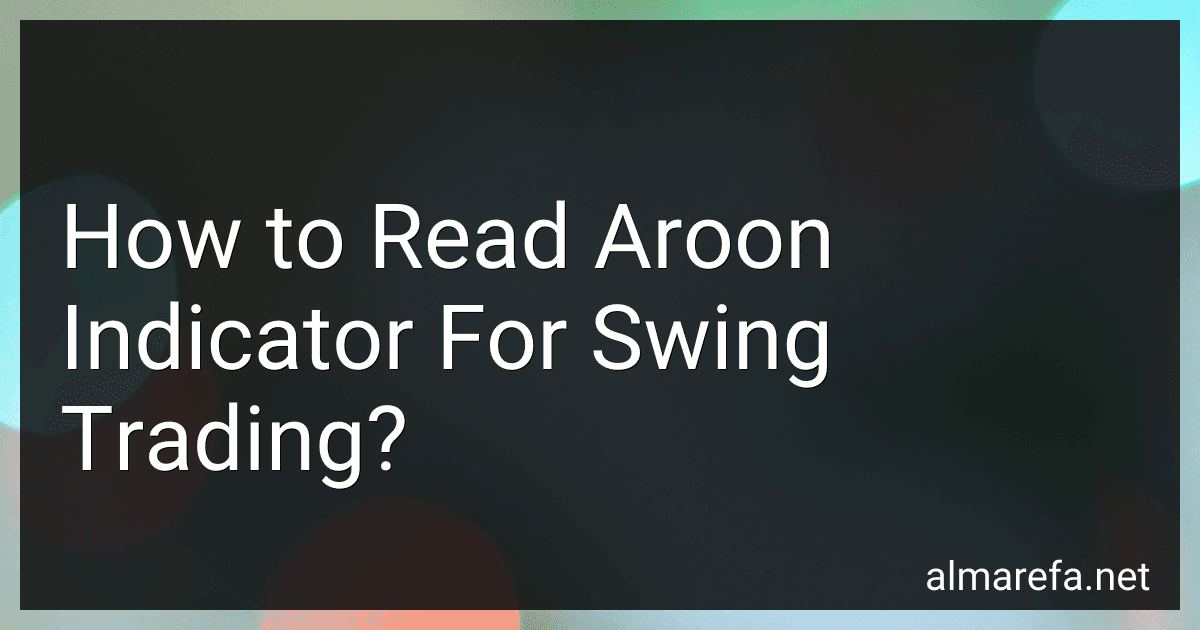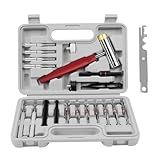Best Aroon Indicator Tools to Buy in November 2025
The Aroon Indicator is a technical analysis tool used in swing trading to identify trend reversals and potential entry or exit points. It is composed of two lines: the Aroon Up line and the Aroon Down line. Understanding how to read the Aroon Indicator can help swing traders make more informed decisions.
The Aroon Up line measures how long it has been since the highest high within a specified period, while the Aroon Down line calculates how long it has been since the lowest low within the same period. Both lines oscillate between 0 and 100.
When the Aroon Up line is above 70 and the Aroon Down line is below 30, it suggests a strong upward trend is in place, indicating a potential buying opportunity. Conversely, when the Aroon Down line is above 70 and the Aroon Up line is below 30, it indicates a strong downward trend, implying a potential selling opportunity.
Crossing over of the Aroon lines can also provide valuable signals. If the Aroon Up line crosses above the Aroon Down line, it suggests a bullish trend, while a cross below indicates a bearish trend. Traders typically wait for a crossover accompanied by the lines being above 50 in order to confirm the strength of the trend.
Additionally, traders often look for divergences between price movement and the Aroon Indicator. For example, if the price is making higher highs, but the Aroon Up line is making lower highs, it may indicate a weakening of the upward trend and potential trend reversal. Vice versa, if the price is making lower lows while the Aroon Down line is making higher lows, it could imply weakening of the downward trend.
It is important to note that while the Aroon Indicator provides valuable insights, it should be used in conjunction with other technical analysis tools and indicators to validate trading decisions. Applying risk management techniques and considering market conditions is crucial for successful swing trading.
What are the limitations of the Aroon Indicator for swing trading?
The Aroon Indicator, like any technical indicator, has certain limitations when used for swing trading. Some of these limitations include:
- Lagging nature: The Aroon Indicator is a lagging indicator, which means it reflects the past price action rather than predicting future movement. This can make it less effective for anticipating market reversals or identifying entry and exit points in real-time.
- Lack of trend strength: The Aroon Indicator does not provide information about the strength or intensity of a trend. It only measures the time elapsed since the highest or lowest price occurred. This can lead to false signals or misleading interpretations if trends lack sufficient momentum.
- Not suitable for range-bound markets: The Aroon Indicator is primarily designed to identify trending markets. It may not work well in range-bound or sideways markets where price is mostly oscillating between support and resistance levels. False signals can be generated as the indicator attempts to identify trending conditions in a non-trending market.
- Limited in predicting price targets: While the Aroon Indicator can help identify the beginning or end of a trend, it does not provide specific price targets. Traders still need to use additional tools or techniques to determine potential profit targets or stop-loss levels.
- Sensitivity to price fluctuations: The Aroon Indicator can give conflicting signals or frequent fluctuations in choppy or volatile markets. Sudden price movements or short-term fluctuations may lead to inaccurate readings or signals, making it difficult to rely solely on this indicator for swing trading decisions.
- Over-optimization and subjective parameter settings: The Aroon Indicator requires setting parameters such as the lookback period. Different parameter values may yield different signals and outcomes. Traders need to identify optimal parameter settings, which can be subjective and prone to over-optimization bias.
- False signals during price gaps: The Aroon Indicator does not account for price gaps, where the current high or low may be significantly different from the previous one due to overnight or intraday gaps. This can potentially generate false signals or inaccuracies in swing trading strategies.
It is important for traders to understand these limitations and use the Aroon Indicator in conjunction with other indicators, technical analysis tools, or fundamental analysis to make informed and well-rounded swing trading decisions.
How to determine when to enter a swing trade using the Aroon Indicator?
To determine when to enter a swing trade using the Aroon Indicator, follow these steps:
- Understand the Aroon Indicator: The Aroon Indicator is a technical analysis tool that helps measure the strength and direction of a trend. It consists of two lines - Aroon Up and Aroon Down. Aroon Up measures the strength of the uptrend, while Aroon Down measures the strength of the downtrend.
- Look for high readings: If the Aroon Up line is near 100 and the Aroon Down line is near 0, it suggests a strong upward trend. This may be a good time to enter a long or buy position.
- Look for low readings: Conversely, if the Aroon Down line is near 100 and the Aroon Up line is near 0, it suggests a strong downward trend. This may be a good time to enter a short or sell position.
- Confirm with other indicators: Utilize other technical indicators or analysis techniques to confirm the Aroon Indicator's signal. This can help increase the reliability of your trade decision.
- Set stop-loss and take-profit levels: Once you determine a suitable entry point based on the Aroon Indicator, set your stop-loss and take-profit levels to manage risk and lock in potential profits.
Remember, like any other technical indicator, the Aroon Indicator is not foolproof and should be used in conjunction with other analysis tools to make well-informed trading decisions. It's essential to practice proper risk management and thoroughly understand the market dynamics before entering any trade.
How to use the Aroon Indicator to identify potential trend continuations?
To use the Aroon Indicator to identify potential trend continuations, follow these steps:
- Understand the Aroon Indicator: The Aroon Indicator consists of two lines - Aroon Up and Aroon Down. Aroon Up measures the number of periods since the highest high, while Aroon Down measures the number of periods since the lowest low. The values range from 0 to 100, where 100 indicates a new high or low.
- Identify a trend: Look for a strong and clearly defined uptrend or downtrend on your price chart. A strong trend is characterized by higher highs and higher lows in an uptrend, or lower highs and lower lows in a downtrend.
- Monitor the Aroon Indicator: Plot the Aroon Up and Aroon Down lines on your chart. When the Aroon Up line remains near 100 and the Aroon Down line remains near 0, it suggests a strong uptrend. Conversely, when the Aroon Up line remains near 0 and the Aroon Down line remains near 100, it suggests a strong downtrend.
- Look for pullbacks: Identify periods where the Aroon Indicator retraces back towards the 50 level but does not cross it. These are potentially good entry points for trend continuation trades.
- Confirm with price action: While the Aroon Indicator provides valuable insight, it should be used in conjunction with price action analysis. Look for price patterns, support and resistance levels, and other technical indicators that confirm the continuation of the trend.
- Set your stop-loss and take-profit levels: Determine appropriate levels to manage your risk and protect your profits. Stop-loss orders can be placed below swing lows in an uptrend and above swing highs in a downtrend.
- Execute the trade: Once the Aroon Indicator, price action, and other factors align, enter the trade in the direction of the trend continuation. Continuously monitor the Aroon Indicator to assess the strength of the trend and potential exit points.
Remember, no indicator is foolproof, and it's always recommended to use additional analysis and risk management techniques when making trading decisions.
How to read the Aroon Indicator for short-term swing trades?
The Aroon Indicator is a technical analysis tool used to identify trends in the market and the strength of those trends. It consists of two lines: Aroon Up and Aroon Down.
To read the Aroon Indicator for short-term swing trades, you can follow these steps:
- Interpret the Aroon Up line: The Aroon Up line measures the strength of the current uptrend. It ranges from 0 to 100, with 100 indicating a strong uptrend. If the Aroon Up line is above 70, it suggests a strong bullish trend. If it is below 30, it indicates a weak or no uptrend.
- Interpret the Aroon Down line: The Aroon Down line measures the strength of the current downtrend. Similar to the Aroon Up line, it ranges from 0 to 100. If the Aroon Down line is above 70, it suggests a strong bearish trend. If it is below 30, it indicates a weak or no downtrend.
- Identify crossovers: Pay attention to the crossovers between the Aroon Up and Aroon Down lines. When the Aroon Up line crosses above the Aroon Down line, it indicates a potential bullish signal, suggesting that the current downtrend is weakening and the market may reverse to an uptrend. Conversely, when the Aroon Down line crosses above the Aroon Up line, it suggests a potential bearish signal, meaning the current uptrend may weaken, and the market could reverse to a downtrend.
- Confirm with price action and other indicators: While the Aroon Indicator can provide valuable insights, it is always recommended to combine it with other technical analysis tools and consider price action. Look for confirmation of the trend reversal signaled by the Aroon Indicator through price patterns, support and resistance levels, and other indicators like moving averages or momentum oscillators.
Remember that the Aroon Indicator is not foolproof and should be used in conjunction with other analysis techniques to increase the probability of successful trades. Additionally, it is crucial to always practice proper risk management and set stop-loss orders to protect against adverse price movements.



